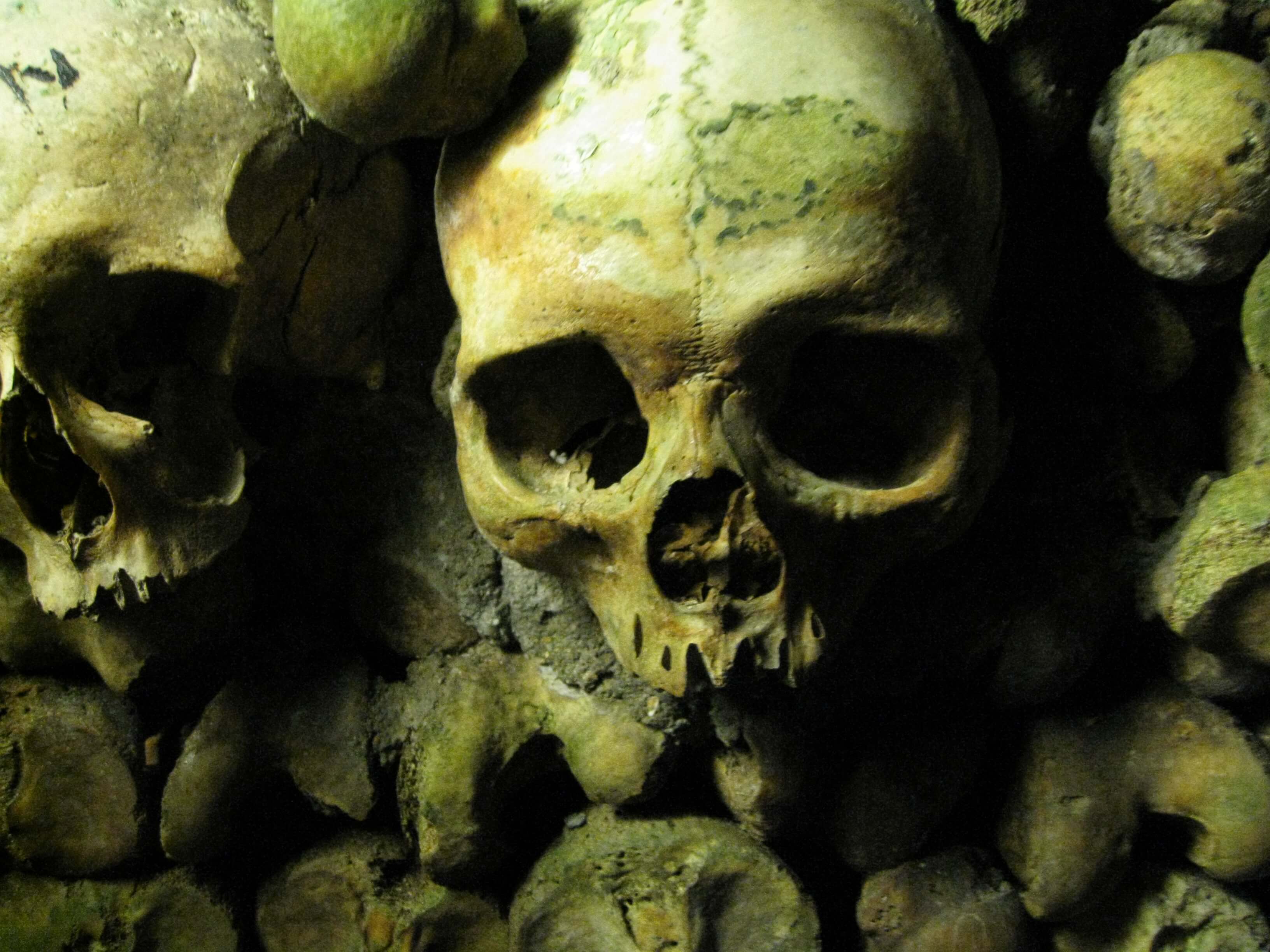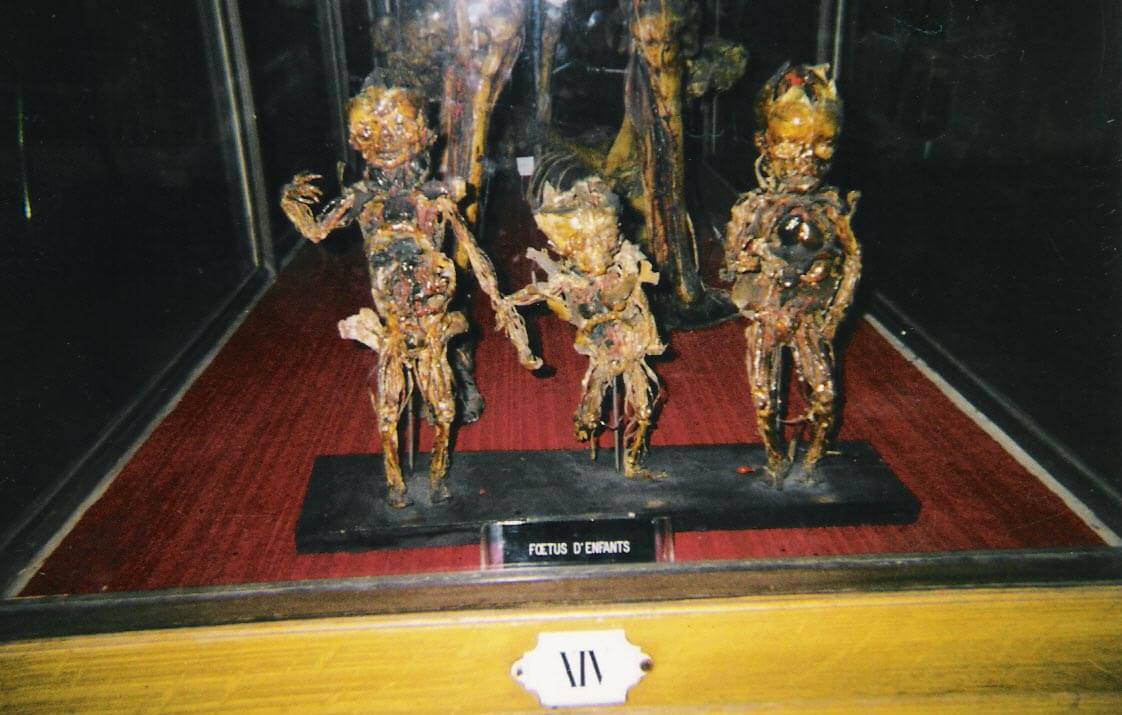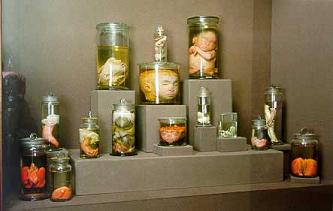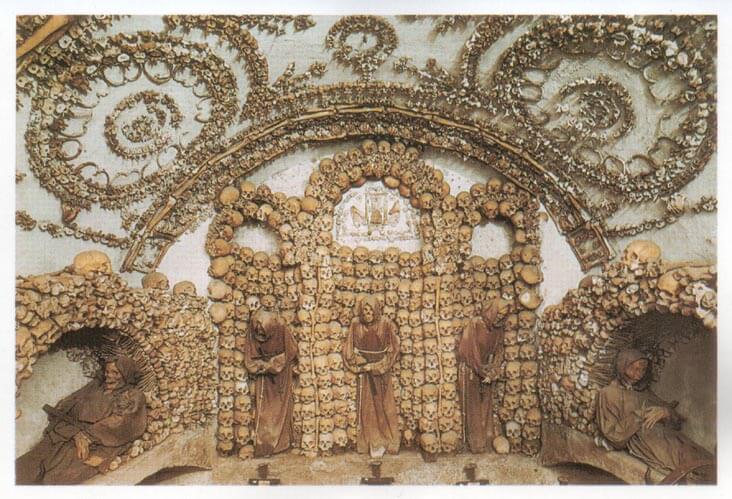Parade of Oddities
What do St. Petersburg, Paris, Rome, and Philadelphia have in common? You know, besides being metropolitan centers for the arts and the homeless? The answer lies in a smallish hall dedicated to the macabre. But, you may be saying, what of the Parisian Catacombs? Don’t you find miles of underground tunnels, which include a very well organized ossuary creepy enough? Well, yeah, you got me there. Walls lined with human bones and floors laden with bone dust is pretty messed up, but have you been to…
Exhibit A: Musee de Fragonard
Housed in the Alfort Veterinary School of Paris, the Museum is a single hall where rows of shelves containing dusty jars filled with formaldehyde and labeled in yellowing hundred-year-old French handwriting explain that you are looking at the two-headed fetus the occasional occurrence of which may have been the basis of Janus mythos. Or, perhaps, the lonely mermaid baby, a fetus with its legs fused and feet resembling the fins of a fish, floating calmly in its jar. The star of the collection, however, is just beyond some animal bones, in a glass cabinet, for it can certainly not be contained in a jar. This is The Horseman, Fragonard’s most impressive Ecorché. Both the horse and his master are flayed, but their flesh and veins are somehow frozen in time. At their feet are three skeletal fetuses, immobilized in festive postures, a gruesome dance of death.
Honoré Fragonard’s method of preservation was never discovered, although it is now being rivaled by the plastination of Gunther von Hagens in his exhibition, Body Worlds. However, Mr. Gunther preserves bodies of donors and they are used for education only, their bodies treated with as much respect as possible. Fragonard practiced his arts in another era, the days of grave robbers and poor houses. This is reflected within the exhibition.
Exhibit B: The Mütter Museum
The College of Physicians of Philadelphia didn’t lag behind Paris when it came to keeping a room of disturbing anomalies… for purposes of education of course. Initially, only doctors were invited to look upon misshapen skeletons and preserved cancerous organs, but it didn’t take too long for the general public to insist on enlightenment. Today anyone can visit this collection of medical curiosities that spans a two-tiered chamber as well as a few connected hallways.
Deformities of the skull are lined up next to a wax representation of the Unicorn Lady who developed a bony growth in her forehead which began to resemble a horn as it grew. Much in this room is a reconstruction, but black and white pictures and stories associated with the exhibits are available for those willing to the take time and learn more. Many of the exhibits are genuine, such as the colon that eventually outgrew its owner. It is shown stuffed with straw with pictures affixed below of the man himself appearing to be pregnant with this benign growth, which nevertheless ended his life. Another exhibit is that of Harry Raymond Eastlack who inherited a rare genetic disorder called Fibrodusplasia Ossificans Progressiva. In essence, bony growths sprouted through his muscles, tendons, ligaments and any other connective tissue. His family donated his skeleton in hopes of raising awareness of the condition.
Exhibit C: Kunstkamer of St. Petersburg, Russia.
Czar Peter the Great, who built St. Peterburg on uninhabitable marshes as well as the very bodies of the builders, decided to give his country its very first museum in the early 18th century. Also known as Peter the Great’s Museum of Anthropology and Ethnography, the museum is jam packed with history. However, initially, Kunstkamer was a menagerie of the curiously deformed. It is said that Peter the Great offered payment to anyone who could bring him an oddity and so two-headed lambs and even oddly shaped seashells and butterflies poured in.
All these oddities are currently collected in one poorly ventilated, although expansive room. Kunstkamer means “a room of art” in German (Peter the Great was a great admirer of Western Europe), and some of this art includes very disturbing exhibits, such as a human child, perhaps a year old, whose only fault was a cleft lip, as well as two human fetuses, only one with an intact head, its face contorted and mouth gaping, as it and his headless sibling cling to each other.
Exhibit D: The Capuchini Bone Chapel
And now we come to Rome, Italy; the city famous for housing the Vatican, nearby streets lined with shops selling Catholic Regalia, or homes in disrepair and reeking of piss. Another, somewhat less known place of worship within this city is the Capuchin Church of the Immaculate Conception. In its Crypt the bones of generations of Capuchin monks are arranged. It would be unfair to say that they “lie” there for they were not so passively employed. The monkish bones comprised wall decorations, chandeliers, chairs, tables; in one word—everything, excepting the walls themselves.
Some years ago the Monks were forced to pack up and move to their current location, and instead of leaving their dead brethren behind, they dug them up and creatively stored the bones. The effect is not as haunting as it is pleasing, except in the last room, which contains a masterpiece of three skeletons, an hourglass, and a sign sketched out in bone that in English means: “As you are now, we once were. As we are, you will soon be.”
I visited these four locations in my travels and I hope that when you visit these cities you will remember to step off the beaten path ever so slightly. Take a few hours away from the Louvre, the Vatican, the Hermitage or Jake’s Philadelphia Cheese Steaks and go see these other, less appetizing, but no less fascinating places.
Many of these institutions make it easy to experience their collections from the comfort of your own home, or at least get a taste of the grotesque, through virtual tours. So, don’t be shy and check out the links below.
- The Catacombs of Paris
- Musee de Fragonard
- Body Worlds
- Read more about Body Worlds here – Revisiting Dead Bodies Under Glass
- The Mütter Museum
- Kunstkamer
- The Capuchini Bone Chapel





I suspected that the method used by Honoré Fragonard may have been similar to plastination by coating the tissue and injecting it with a preservative, as can be seen by the amazingly well kept shape of the veins in the horse. If you look on the museum’s website it explains that he used injections and coatings of wax to achieve the effect, much like the use of plastic in modern techniques.
Also Fibrodysplasia Ossificans Progressiva isn’t bone protrusions through muscle and skin, it is actually the soft tissue turning into bone. The horrific nature of this is well seen in skeletons of its victims where muscle has been ossified and permanently frozen in place.
That last place looks genuinely amazing, I have seen that quote before, I think it’s from a medieval poem/song called the Dance of Death which tells of a party going astray on horseback and coming across skeletons singing those lines and dancing in the forest.
Thanks for the comment :) I think you’re right in terms of Fragonard’s technique being similar to plastination, but since they didn’t have plastic around and wax can only do so much, they still haven’t worked out what injections he used to preserve the tissues.
Thanks for the amendment on my description of the disease, though I didn’t mention that it went through skin, just that it took over muscles, tendons, etc.
Of all these places, Kunstkammer in St. Petersburg was the most unbelievable, but the Bone Chapel is pretty breath taking. I’d love to read that story you mentioned. I’ll see if Google provides.